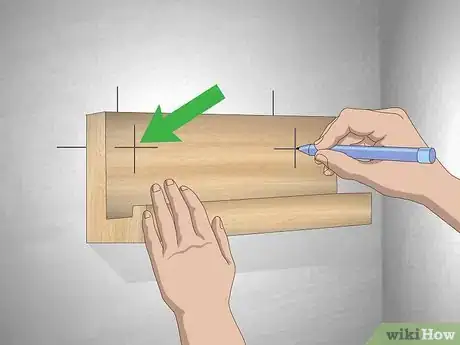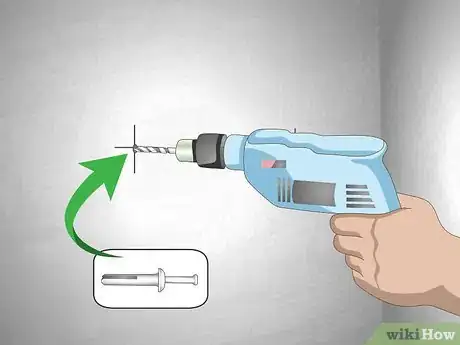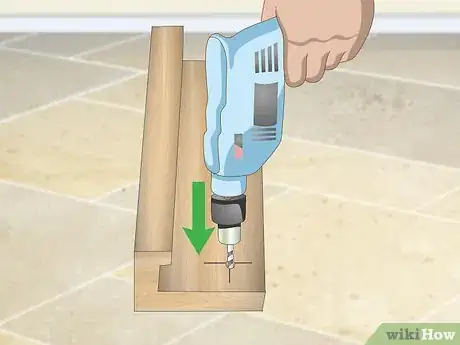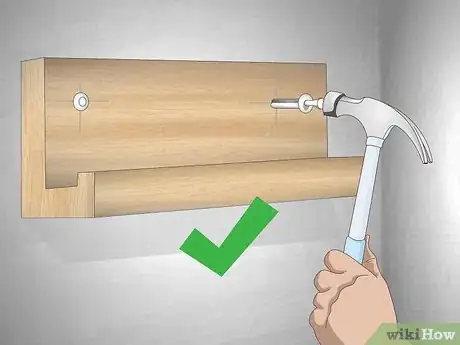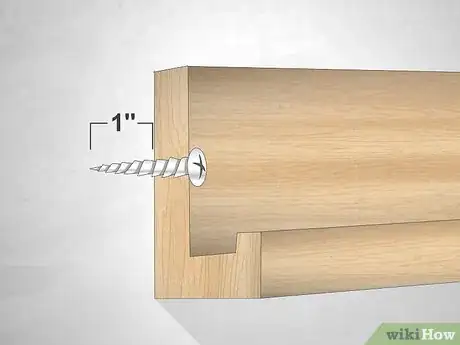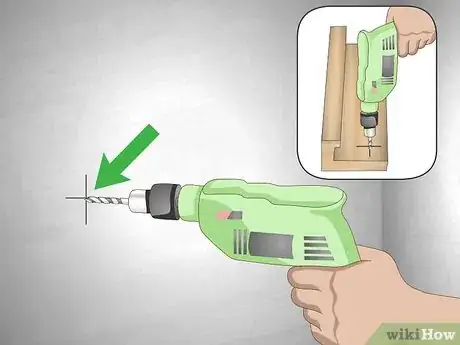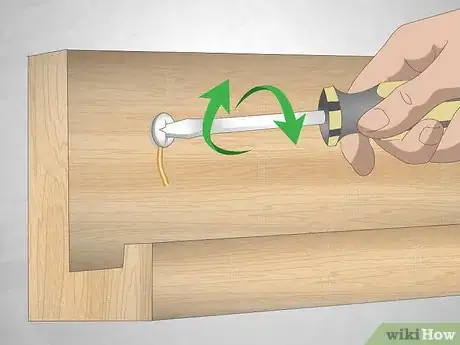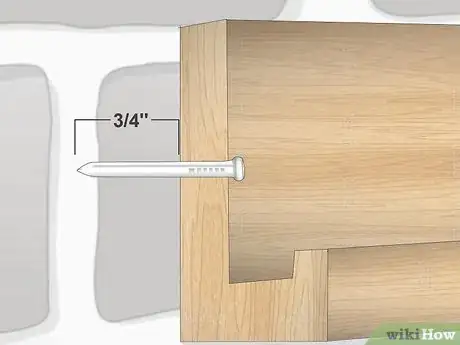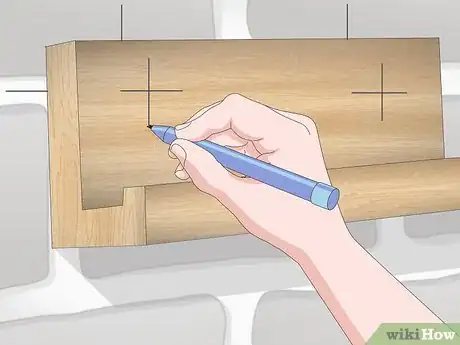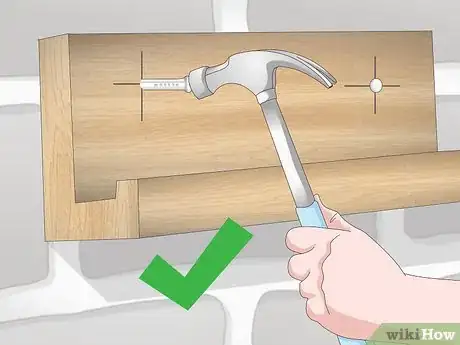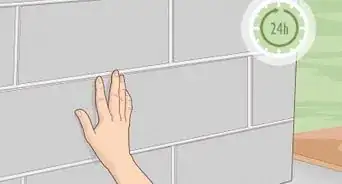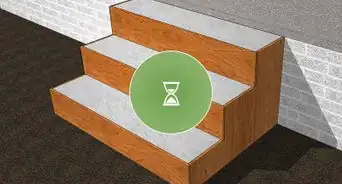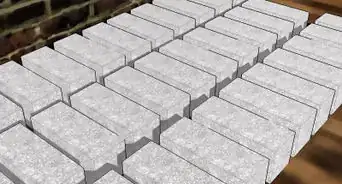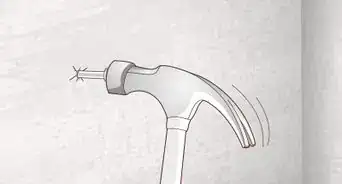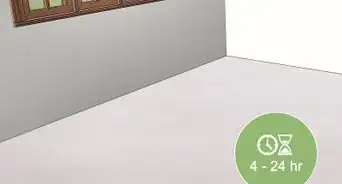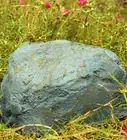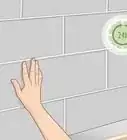This article was co-authored by Sam Hubbard. Sam Hubbard is a Professional Carpenter and the Owner of Hubbard Carpentry and Remodeling. He has over 19 years of experience in the industry. Sam specializes in kitchen remodels, home woodworking, cabinetry, and handyman services.
There are 7 references cited in this article, which can be found at the bottom of the page.
This article has been viewed 124,931 times.
Connecting wood to concrete can seem intimidating but, with the right tools, even an amateur craftsman can do it. You can fasten wood to concrete using 3 different methods, depending on your preference. Hammer-set concrete fasteners, concrete screws, and mortar nails are all effective ways to connect wood to concrete. Once you've determined the right method for your project, you can easily fasten wood and concrete objects!
Steps
Using Hammer-Set Concrete Fasteners
-
1Align the concrete with the wood block. Mark where you will drill in both with a permanent marker. The spots you mark are the areas you plan to concrete the concrete and wood with the hammer-set concrete fasteners. This will keep your drill holes precise so your fasteners will fit securely into the wood and concrete.
- You will need hammer-set concrete fasteners to connect the wood and concrete, which you can get online or from most home improvement stores.
-
2Predrill a hole in the concrete. Drill a hole into the concrete approximately 1⁄4 inch (0.64 cm) deeper than your concrete fastener. When you're finished drilling, blow any remaining concrete dust out of the hole with a small vacuum.[1]
- Take all necessary safety precautions while using a drill, and put on safety goggles and professional-grade earmuffs beforehand.
- In a pinch, you can also use a syringe blower to remove the dust.
Advertisement -
3Drill a hole through the wood. Using your screw markings as guides, align the wood with the concrete object and drill through the wood into the drilled concrete hole. This will help you make sure that the holes are aligned.
- Unlike the concrete, where you only have to drill 1⁄4 inch (0.64 cm) deeper than the fastener's length, you should drill completely through the wood.
-
4Drive the anchor through the wood and concrete. Keeping the wood and concrete holes aligned, position the fastener into the hole and hammer it through. After driving it through the hole, the concrete fastener should expand at the back and wedge itself tightly into the concrete.[2]
Trying Concrete Screws
-
1Select concrete screws based on the length of the intended hole. Your screw should be long enough to penetrate completely through the wood and at least 1 inch (2.5 cm) into the concrete. Measure the depth of your wood and concrete objects, and purchase screws that will fasten the wood securely.[3]
- Although 1 inch (2.5 cm) of concrete penetration is the minimum, deeper penetration will result in a stronger hold. The longer your screws are, the tighter they will connect the wood and concrete.
- Concrete screws are the newest method of fastening wood to concrete and generally the most popular because they are easy to remove.[4]
-
2Predrill holes into the concrete and wood. The holes should be approximately the same diameter as the screws that you're using. Drill completely through the wood and about 1⁄4 inch (0.64 cm) deeper than the screw's length into the concrete.[5]
- Mark the holes in the concrete and wood using a permanent marker first to make sure your holes are precise.
- Blow the residual dust out of the concrete hole using a vacuum or syringe blower.
-
3Insert a piece of copper wire into the holes. Copper wire ensures that the concrete screws will fit tightly into the hole. Cut a piece of copper wire approximately the same length as the concrete and wood hole, and thread it through the holes before you drive the screw in.[6]
-
4Drive the screw through the wood and concrete. Use a drill or screwdriver to drive the screw completely through the wood and concrete holes. If you are driving multiple screws, use the first screw you drive in as a test screw to make sure the hole is deep enough and you've used enough wire.[7]
- You will know that you have used enough copper wire if the screw fits tightly into the hole and the connection between the wood and concrete is not loose or wobbly.
- Thread extra copper wire through the hole if it's too large for the screw.[8]
Attaching Wood with Mortar Nails
-
1Use mortar nails on concrete blocks secured with mortar. Because these nails are not strong enough to hammer through concrete, try this option only if your concrete was secured using mortar. If your concrete object was not connected with mortar, you must use concrete screws or fasteners instead.[9]
- Mortar nails are generally the cheapest attachment option for wood and concrete.
-
2Select nails that will penetrate at least 3⁄4 inch (1.9 cm) into the concrete. Your mortar nails should go through the wood entirely and penetrate the concrete by 3⁄4 inch (1.9 cm), if possible. If you can find nails that will penetrate the concrete deeper than 3⁄4 inch (1.9 cm), this can create an even more secure hold.[10]
-
3Mark and align the holes in the wood and mortar. Indicate where you intend to put holes in the wood and concrete objects with a permanent marker. Using these markings as a guide, place the wood marking directly over your concrete marking. The wood should lie flat against the concrete object.[11]
- Make sure the marked area you choose for the concrete object is in the mortar, not the concrete itself.
-
4Drive the nails into the wood and mortar with a hammer. Use sharp, powerful blows to work the fastener through to the bottom of the hole. Continue hammering until you drive the nail completely in and cannot hammer it further.
- Put on safety goggles before hammering the nail into the wood and mortar.[12]
Warnings
- You're more likely to crack or chip the concrete if you drill close to the edge. Don't drill any closer than 4 inches (10 cm) from the concrete's edge, if possible.[13]⧼thumbs_response⧽
- Avoid using wedge-type concrete fasteners, which exert more pressure and can crack the concrete over time.[14]⧼thumbs_response⧽
- Always wear eye protection while drilling or nailing into concrete to prevent flying stone chips from injuring your eyes.[15]⧼thumbs_response⧽
Things You’ll Need
Using Hammer-Set Concrete Fasteners
- Permanent marker
- Concrete fasteners
- Drill
- Hammer
- Vacuum or syringe blower
Trying Concrete Screws Instead
- Concrete screws
- Drill
- Copper wire
Attaching Wood with Mortar Nails
- Mortar nails
- Hammer
References
- ↑ https://www.bhg.com/home-improvement/walls/how-to-fasten-an-interior-wall-to-concrete/
- ↑ https://www.familyhandyman.com/masonry/pouring-concrete/how-to-choose-and-use-concrete-fasteners/view-all/
- ↑ https://www.bhg.com/home-improvement/walls/how-to-fasten-an-interior-wall-to-concrete/
- ↑ https://www.popularmechanics.com/home/tools/reviews/g1314/how-to-fasten-anything-to-concrete/
- ↑ https://www.popularmechanics.com/home/tools/reviews/g1314/how-to-fasten-anything-to-concrete/
- ↑ https://www.protradecraft.com/video/carpentry-tip-attach-wood-concrete-construction-screws
- ↑ https://www.protradecraft.com/video/carpentry-tip-attach-wood-concrete-construction-screws
- ↑ https://www.protradecraft.com/video/carpentry-tip-attach-wood-concrete-construction-screws
- ↑ http://articles.latimes.com/1991-08-04/realestate/re-493_1_concrete-nails
- ↑ http://www.nytimes.com/1999/03/07/nyregion/home-clinic-methods-to-bond-wood-to-concrete.html
- ↑ http://www.nytimes.com/1999/03/07/nyregion/home-clinic-methods-to-bond-wood-to-concrete.html
- ↑ https://www.bhg.com/home-improvement/walls/how-to-fasten-an-interior-wall-to-concrete/
- ↑ https://www.constructionprotips.com/jobsite-tips/tips-for-concrete-fasteners-and-masonry-screws/
- ↑ https://www.constructionprotips.com/jobsite-tips/tips-for-concrete-fasteners-and-masonry-screws/
- ↑ http://www.nytimes.com/1999/03/07/nyregion/home-clinic-methods-to-bond-wood-to-concrete.html
About This Article
Connecting wood to concrete can seem intimidating, but you can easily do the job using hammer-set concrete fasteners. Start by aligning the wood block with the concrete and marking where you plan to drill to join the pieces together. Predrill a 1/4-inch hole in the concrete, then align the wood with the concrete and drill through it straight into the drilled concrete hole. Keeping the wood and concrete holes aligned, position the fastener into the hole and hammer it through. The concrete fastener will then expand at the back and wedge itself tightly into the concrete. To learn how to connect wood to concrete with concrete screws, keep reading!
